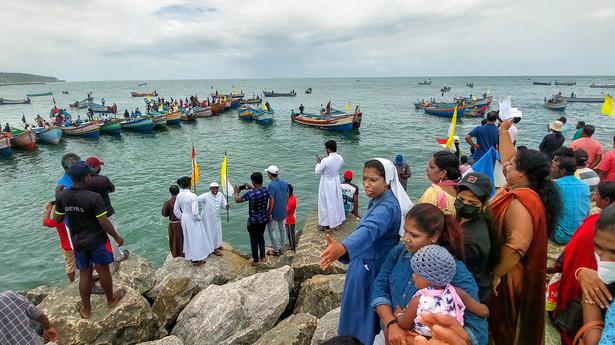
Explained | Why are the fisherfolk demanding to stop the construction of Vizhinjam port project
The Hindu
Why have the fisherfolk living in and around Vizhinjam laid siege to the international port project? Is the port construction causing increased sea erosion in the area?
The story so far: Vizhinjam, a small coastal village that lies around 20 km south of Thiruvananthapuram, is on the boil for the past two weeks with fisherfolk and their families laying siege to the under-construction Vizhinjam International Seaport, from both sea and land. The protestors led by the Latin Archdiocese, Thiruvananthapuram, have been holding day-and-night sit-ins in front of the port since August 16, disrupting the construction work by the Adani Vizhinjam Port Private Limited, which is developing the port on Design, Build, Finance, Operate, Transfer (DBFOT) basis.
Though the Kerala Government reached out to protestors, the fisherfolk led by the Catholic Church, refused to halt the protest saying any compromise without stopping the work on the ₹7,500-crore all-weather port is not acceptable.
According to fisherfolk, the port work has aggravated the coastal erosion along the coast of Thiruvananthapuram. A scientific study to assess the impact of the port work on the shoreline has to be conducted urgently by stopping the construction. Further, around 300 families along the coastline were shifted to relief camps after their houses were destroyed due to high-intensity coastal erosion. The protesters demand a comprehensive rehabilitation package, an assured minimum wage when the sea turns rough due to inclement weather and subsidised kerosene for boats.
Also read: Vizhinjam port | In troubled waters
In fact, all type of construction works along a coast aggravate sea erosion (loss of beach) and accretion (gain of beach). The longshore drift along the coast of Kerala with waves approaching the beach at a certain angle (mostly from south to northwards) has been transporting the sand along with waves, resulting in erosion and accretion based on the topography of each terrain. Any structure — be it groyne, seawall, or breakwater — intensifies erosion on one side and accretion on the other. Although coastal erosion is dominant in all coastal districts of Kerala, it is more severe along the coastline of Thiruvananthapuram.
A study ‘shoreline assessment for Kerala coast’ conducted by the National Centre for Sustainable Coastal Management (NCSCM), Society of Integrated Coastal Management, and the Ministry of Environment and Forest by assessing the shoreline changes for a period of 38 years from 1972 to 2010 in Kerala, had noted that the erosion is minimum at Thrissur (1.5 %) and maximum at Thiruvananthapuram (23%), even before the port construction. In the case of Kerala, the seasonal shoreline changes would be more severe during monsoon months due to the high-energy short storm waves that lash the coast almost in a perpendicular position moving the sand offshore.
The latest report of the expert committee appointed by the National Green Tribunal (NGT) and Shoreline Monitoring Cell formed to monitor the shoreline changes in the project area — within 10 km on either side of the port — observed that erosion in spots such as Valiyathura, Shanghumugham, and Punthura remains the same before and after the commencement of the port construction (December 2015). However, during the October 2020–September 2021 period, spots like Kochuveli and Cheriyathura to the north of Valiyathura suffered erosion, and accretion was noted in some other spots.





















 Run 3 Space | Play Space Running Game
Run 3 Space | Play Space Running Game Traffic Jam 3D | Online Racing Game
Traffic Jam 3D | Online Racing Game Duck Hunt | Play Old Classic Game
Duck Hunt | Play Old Classic Game











